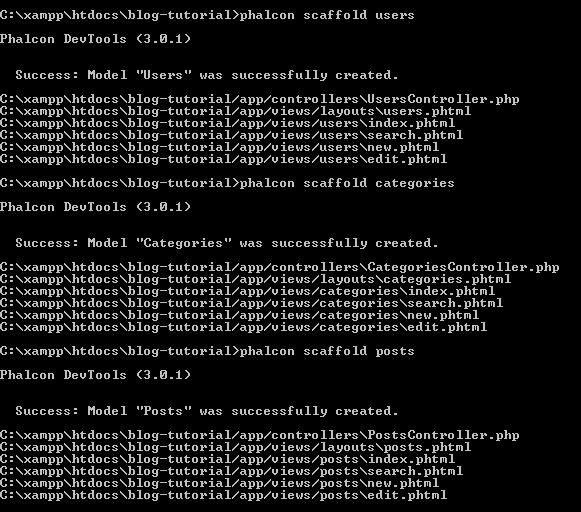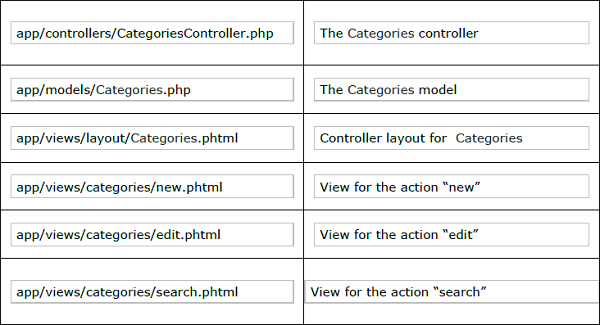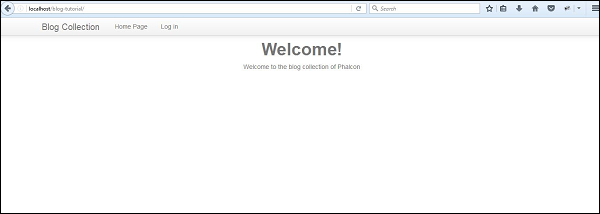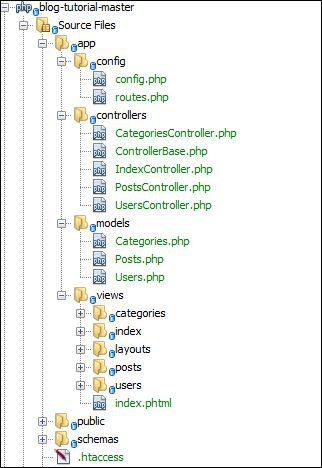
- Phalcon - Home
- Phalcon - Overview
- Phalcon - Environmental Setup
- Phalcon - Application Structure
- Phalcon - Functionality
- Phalcon - Configuration
- Phalcon - Controllers
- Phalcon - Models
- Phalcon - Views
- Phalcon - Routing
- Phalcon - Database Connectivity
- Phalcon - Switching Databases
- Phalcon - Scaffolding Application
- Phalcon - Query Language
- Phalcon - Database Migration
- Phalcon - Cookie Management
- Phalcon - Session Management
- Phalcon - Multi-Lingual Support
- Phalcon - Asset Management
- Phalcon - Working with Forms
- Phalcon - Object Document Mapper
- Phalcon - Security Features
Phalcon - Scaffolding Application
Scaffolding usually refers to a type of code generation where we point it to a web application database, which results in creating a basic CRUD (Create, Read, Update, Delete) application.
Before designing a CRUD application, it is important to design database tables as per the need of the application.
Step 1 − Create a scaffolding application which will include all crud operations.
Command: phalcon scaffold <table-name>


The scaffold generator of Phalcon once executed will create files and folders which are described in the following table.

Step 2 − Create an index page (Combination of phtml and volt).
Code to be included in index.phtml in users folder.
<?php use Phalcon\Tag as Tag ?>
<!DOCTYPE html>
<html>
<head>
<meta charset = "utf-8">
<title>Blog Tutorial</title>
<link rel = "stylesheet" type = "text/css"
href = "http://netdna.bootstrapcdn.com/twitter-bootstrap/2.2.1/css/bootstrapcombined.min.css"/>
<meta name = "viewport" content = "width = device-width, initial-scale = 1.0">
</head>
<body>
<div class = "navbar navbar-fixed-top">
<div class = "navbar-inner">
<div class = "container">
<a class = "btn btn-navbar" data-toggle = "collapse" datatarget = ".nav-collapse">
<span class = "icon-bar"></span>
<span class = "icon-bar"></span>
<span class = "icon-bar"></span>
</a>
<a class = "brand" href = "#">Blog Collection</a>
<div class = "nav-collapse">
<ul class = "nav pull-left">
<li>
<?php echo Phalcon\Tag::linkTo('index', 'Home Page') ?>
</li>
<?php if ($this->session->has('auth')) { ?>
<li>
<?php echo Phalcon\Tag::linkTo('posts/index', '+Posts') ?>
</li>
<li>
<?php echo Phalcon\Tag::linkTo('categories/index', '+Categories') ?>
</li>
<li>
<?php echo Phalcon\Tag::linkTo('users/logout', 'Log out') ?>
</li>
<?php } else { ?>
<li>
<?php echo Phalcon\Tag::linkTo('users/index', 'Log in') ?>
</li>
<?php } ?>
</ul>
</div>
</div>
</div>
</div>
<?php echo $this->getContent() ?>
<script src = "http://netdna.bootstrapcdn.com/twitterbootstrap/2.2.1/js/bootstrap.min.js"></script>
</body>
</html>
Default file index.volt will include the following code.
<?php echo $this->getContent() ?> <div align = "center"> <h1>Welcome!</h1> <p>Welcome to the blog collection of Phalcon</p> </div>
Successful execution of the above code produces the following output.

Step 3 − Change with the respective models.
Users.php
<?php
class Users extends \Phalcon\Mvc\Model {
/**
* @var integer
*
*/
public $id;
/**
* @var string
*
*/
public $login;
/**
* @var string
*
*/
public $password;
/**
* Initializer method for model.
*/
public function initialize() {
$this->hasMany("id", "Posts", "users_id");
}
}
The function named initialize helps in implementing relationship between id and users_id in Posts table, which means that each unique user has many posts associated in the table.
Posts.php
<?php
class Posts extends \Phalcon\Mvc\Model {
/**
* @var integer
*
*/
public $id;
/**
* @var string
*
*/
public $title;
/**
* @var string
*
*/
public $slug;
/**
* @var string
*
*/
public $content;
/**
* @var string
*
*/
public $created;
/**
* @var integer
*
*/
public $users_id;
/**
* @var integer
*
*/
public $categories_id;
/**
* Initializer method for model.
*/
public function initialize() {
$this->belongsTo("users_id", "Users", "id");
$this->belongsTo("categories_id", "Categories", "id");
}
}
The function initialize includes relationship constraint mentioning the foreign key and primary key relationship with the table.
users_id refers to id in Users table.
categories_id refers to id in Categories table.
Categories.php
<?php
class Categories extends \Phalcon\Mvc\Model {
/**
* @var integer
*
*/
public $id;
/**
* @var string
*
*/
public $name;
/**
* @var string
*
*/
public $slug;
/**
* Initializer method for model.
*/
public function initialize() {
$this->hasMany("id", "Posts", "categories_id");
}
}
Similar to Users model, the initialize function specifies that it includes many categories_id for the given post.
Creating Views
Following is the complete structure of Blog-tutorial-master project.

The associated view for displaying the home page after the user successfully logs in is index.phtml.
<?php use Phalcon\Tag as Tag ?>
<!DOCTYPE html>
<html>
<head>
<meta charset = "utf-8">
<title>Blog Tutorial</title>
<link rel = "stylesheet" type = "text/css" href = "http://netdna.bootstrapcdn.com/twitter-bootstrap/2.2.1/css/bootstrapcombined.min.css"/>
<meta name = "viewport" content = "width = device-width, initial-scale = 1.0">
</head>
<body>
<div class = "navbar navbar-fixed-top">
<div class = "navbar-inner">
<div class = "container">
<a class = "btn btn-navbar" data-toggle = "collapse" datatarget = ".nav-collapse">
<span class = "icon-bar"></span>
<span class = "icon-bar"></span>
<span class = "icon-bar"></span>
</a>
<a class = "brand" href = "#">Blog Collection</a>
<div class = "nav-collapse">
<ul class = "nav pull-left">
<li>
<?php echo Phalcon\Tag::linkTo('index', 'Home Page') ?>
</li>
<?php if ($this->session->has('auth')) { ?>
<li>
<?php echo Phalcon\Tag::linkTo('posts/index', '+Posts') ?>
</li>
<li>
<?php echo Phalcon\Tag::linkTo('categories/index', '+Categories') ?>
</li>
<li>
<?php echo Phalcon\Tag::linkTo('users/logout', 'Log out') ?>
</li>
<?php } else { ?>
<li>
<?php echo Phalcon\Tag::linkTo('users/index', 'Log in') ?>
</li>
<?php } ?>
</ul>
</div>
</div>
</div>
</div>
<?php echo $this->getContent() ?>
<script src = "http://netdna.bootstrapcdn.com/twitterbootstrap/2.2.1/js/bootstrap.min.js"></script>
</body>
</html>